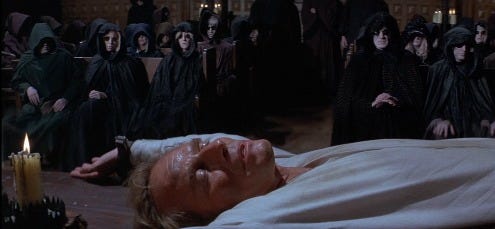The Omega Man (1971)

I'm a sucker for post-apocalyptic stories, and "The Omega Man" is something of a lodestone for fans of this genre. It's based on Richard Matheson's 1954 novel "I Am Legend," which also was the basis for a 1964 Italian cheapie, "The Last Man on Earth," starring Vincent Price. And, of course, there was the underwhelming 2007 Will Smith adaptation.
(At night, when I'm plagued by dreams of crappy movies, I hear Smith in my head: "Get offa my caaaaaaaaaaarrrrr!!")
George Romero has cited the book as his main inspiration for 1968's "Night of the Living Dead," which more or less launched zombie movies and sparked the modern rise of horror films.
There's the bones of a great, great story in there, but none of the films has really done it justice. In some ways, they've all been a captive of their era. If the 2007 movie relied too much on CGI boogums and Smith's by-then wearisome star persona, then "The Omega Man" represents the pinnacle of '70s cheese.
Everything from the clothes to the rock 'n' roll-ish soundtrack to the jive-talkin' black girl serve to anchor the movie firmly in its time, post-Woodstock but pre-Watergate. It was a moment of both hope and disillusionment, when many people were questioning not only our government but the entire American way of life.
But people were not yet jaded and cynical, and there's an almost naive note of hopefulness to the film. It's the sort of flick that can end with the hero dying, but he's set mankind up for salvation before expiring.
I'll say this for "The Omega Man": It certainly stands out in the memory. The image of a track-suited Charlton Heston tooling around an empty Los Angeles downtown carrying a submachine gun stuck in my mind from childhood. It's the sort of movie I probably saw on television as a fairly young child and took with me through my teen years. I probably didn't actually see it for a second time until I was in college.
But the main reasons the film has entered the pop-culture subconscious are mainly related to its innate hokiness. Chief among them are the plague-infested survivors of the germ warfare that killed most of humanity, who have albino skin, white hair and pupils, and tool around in dark robes and wear Ray-Ban sunglasses.
The effect is supposed to be unnerving, but their silly appearance coupled with their penchant for religious-intoned chanting makes them seem like Disco Monks.
They call themselves The Family; their nemesis, Robert Neville, a former Army colonel and scientist, refers to them as plague victims. They're definitely not undead and indeed, during the course of the story, Neville discovers that he can turn someone in the end stages of transformation back to normal.
In the book, Matheson referred to them as vampires since they were light-sensitive and drank blood.
Metaphysically speaking, a few questions are left unanswered. Will those infected with the plague die if left untreated, or do they simply transform into Disco Monks and continue that way the rest of their lives? If so, the exact nature of the conflict between Neville and the family is unclear.
Their cult-like leader, Matthias — a TV newscaster before the world blew up — sees Neville as the final representative of the old world order. Once he's gone, Matthias will be free to remake the planet as he sees fit. Of course, he could go ahead and do that right now, except for the daytime when their eyes cannot stand the sun.
Neville's motivations are even more unclear. Heston plays up his character's intense loneliness — talking to the bust of Caesar with whom he plays chess, etc. If the plague victims are destined to die out, then why does he feel compelled to hasten their progress and put himself at risk? And if he can't, or won't, cure them, why not just avoid them? Could it be that his antagonism with Matthias & Co. is the only human-like interaction he has left?
The film is set in 1977, two years after the supposed end came. The detritus of mankind is holding up pretty well, considering. Neville has several cars in his garage and an apparently inexhaustible supply of gasoline to run them and the generators that power his compound. (Never mind that gas starts to go bad after just a few weeks. By 1977, all he'd have left would essentially be varnish.)
The Family has been moving through the city every night, burning every last vestige of technology it can get its hands on, yet Neville is able to pop into pretty much any store and find perfectly preserved goods, a little bit dusty but ready to take off the shelf. Also, when he's driving around the empty streets of L.A., you can see the traffic lights are still working. (This is probably a continuity error rather than something the filmmakers intended.)
"The Omega Man" is also notable for its interracial love affair between Heston and Rosalind Cash, playing the leader of a small group of survivors, mostly children. Whoopi Goldberg has said that their passionate kiss was one of the first onscreen couplings between a white man and a black woman in popular culture. (It would take a little while longer for the reverse-gender scenario.)
That's fine and good, but Cash's character, Lisa, is a walking gumbo of Black Power cliches, wearing brightly colored African outfits (not so good for hiding out from psychopathic killers), an Afro three times the size of her skull and a mouthful of ridiculously over-the-top dialogue. She transitions from keeping a gun on Neville to sleeping with him so quickly it's positively dizzying.
I keep expecting her to call him a "honky," which is one of the few low spots "The Omega Man" manages to miss.
2 Yaps



